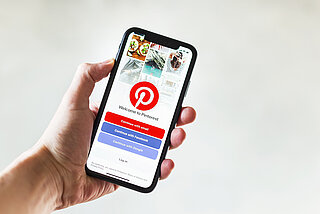
Five tips for Pinterest marketing
How small companies and retailers benefit from the platform
By Christina Widner
Pinterest has been one of the most popular social media platforms for many years as a place where users get inspirations and share pins relating to their interests and hobbies. But what many companies don’t know is that Pinterest is not just a platform for private use but also an effective marketing tool. It offers many benefits to companies.
Through Pinterest marketing, many companies succeed in increasing their reach. They successfully drive traffic to their website and connect better with their existing and with new target groups. Since Pinterest is a visual platform, it is particularly interesting for visually compelling industries, such as fashion, beauty, travel, food and toys. However, automotive, finance or entertainment are relevant as well. People look for inspirations for all areas of their lives.
What is Pinterest?

To understand why Pinterest is so important for small businesses and retailers, you first have to get how the platform works. Pinterest is a personal media platform where users can create and share individual digital pinboards with visual content. Anyone can "pin" images and videos from other websites to their pinboards, upload their own images and videos, and repin content posted by others.
At the same time, the platform can serve as a search engine when looking for suitable content on particular topics. Pinterest is therefore used by many people as a source of inspiration and for planning and organising ideas and projects. Pinterest makes a multitude of tools and features available specifically to businesses so that they can share their content and reach a particular target market.
How does it benefit companies to use Pinterest as a marketing tool?
Pinterest is a visual search engine. If companies want to share creative and appealing images and videos, there is a good chance that the Pinterest community will find the content interesting, remember it and spread it further.
Another advantage of Pinterest is that the platform is relevant for lots of different consumer goods companies – Pinterest can be a useful complement to the marketing mix in visually compelling industries and in other sectors.

Costs are generally a major factor in marketing. The advantage of Pinterest is that the platform is often more affordable for companies than other advertising channels, such as Google Ads and Facebook Ads. That is because companies can showcase their products and services on Pinterest at no additional cost. Depending on the business, it may make sense to make use of the paid-for advertising options on Pinterest, such as Shopping Ads or Carousel Ads. These promotional formats are often more affordable than comparable advertising on other platforms.

One of the key benefits of Pinterest marketing is that companies can better connect with their target group. Active users on the platform usually have something very specific in mind when searching for inspiration and products. 77% of respondents to a study commissioned by Pinterest in Germany say Pinterest shows them something they want to try or buy. This means that companies can appeal to their target group in a really targeted and effective way. Additionally, companies on Pinterest can precisely define target groups based on interests, demographics and search behaviour.

In addition, Pinterest stands out as a positive advertising environment for brands and businesses. Part of Pinterest's global strategy is to be the place on the internet for the most inspiring ideas in a positive and safe environment, which is why the company has proactively taken measures in recent years that contribute to an inspiring environment. These include, for example, industry-leading policies such as banning political ads and weight loss ads. Pinterest has also introduced policies against the spread of misinformation on climate change. Part of a positively perceived experience is that users feel seen and represented. Pinterest has therefore developed new features, such as skin tone selection or hair texture search, to help people find content on Pinterest that matches their personal type. Many advertisers still underestimate the influence of the platform on which they advertise. Yet several studies have confirmed that people are more open to trying things out and buying in an inspiring environment.
Five practical tips for Pinterest marketing
- Create appealing content: Pinterest users are searching for inspiring and visually appealing content. Therefore, make sure that you are posting high-quality, visually compelling content that includes relevant and useful information.
- Use keywords: Pinterest is a search engine. Just as you would for other search engines like Google, use relevant keywords in your pins to ensure that potential customers find you.
- Use pinboards: Create pinboards for various themes of relevance to your target market. Users will then be able to directly follow your brand and focus on your content.
- Link to your website: Include links to your website in your pins so that you can send potential customers directly to your website in the most straightforward possible way.
- Use Pinterest Analytics: Use the free Pinterest Analytics tools, like the Pinterest-Trends-Tool to see which pins are most effective and what appeals to your target group. You can then apply this information to further optimise your Pinterest marketing strategy.
Conclusion: Pinterest marketing should be part of every marketing mix
Pinterest marketing offers small businesses and retailers a straightforward and affordable way to showcase their products and services while increasing brand awareness. By creating visually appealing content, using relevant keywords and putting together pinboards on various topics, small businesses and retailers can better reach their target group and drive more traffic to their website.
About the author:
BASIC thinking is an online magazine and one of the widest-reaching tech portals in German-speaking countries. The editorial team posts daily on social media, marketing and business topics. This article was written by Christina Widner of BASIC thinking GmbH and BASIC thinking International.




